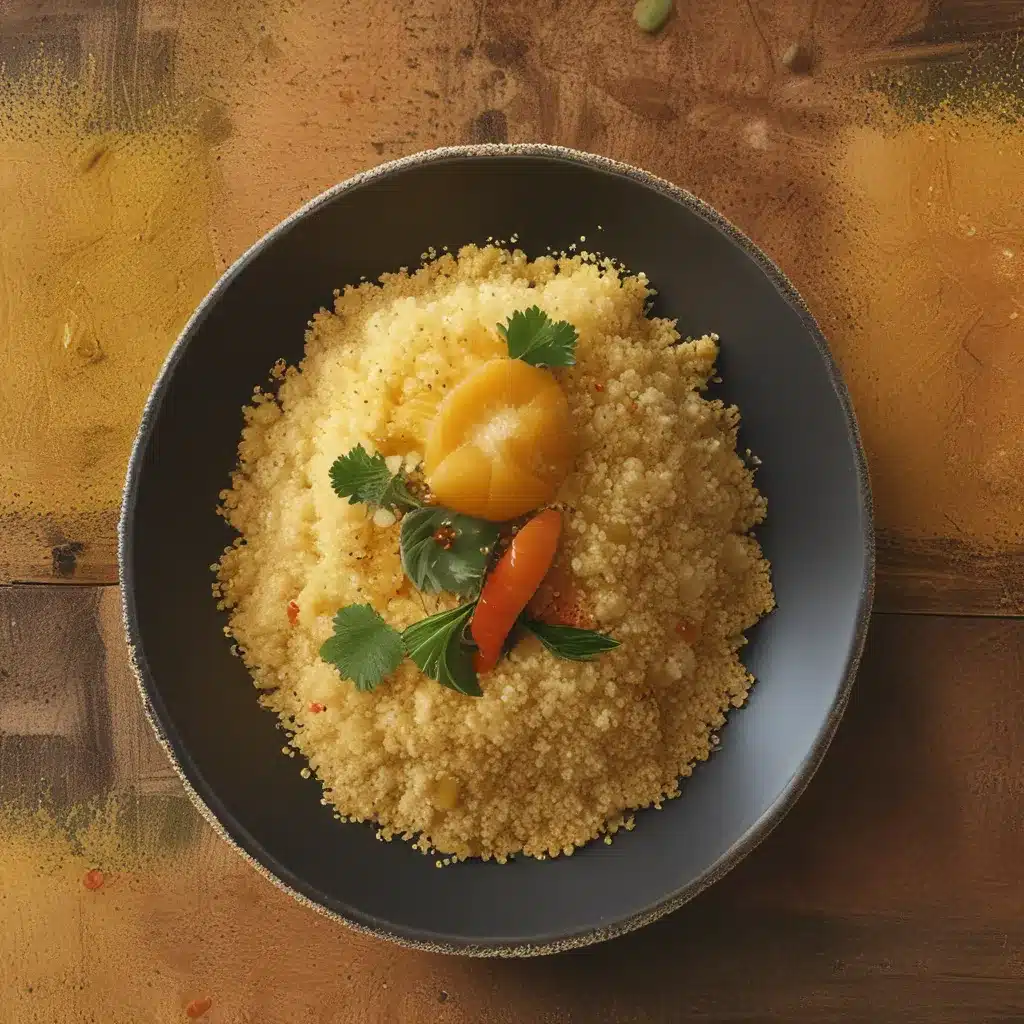
The Humble Grain that Captivated the World
As I stroll through the bustling streets of New York City, the scent of spices and simmering stews wafts through the air, beckoning me to explore the vibrant culinary scene that this city has to offer. But today, my destination is a hidden gem – a Moroccan restaurant tucked away in the heart of the city, where the sacred simplicity of couscous reigns supreme.
The moment I step through the doors, I’m transported to a world of rich cultural heritage and ancient culinary traditions. The walls are adorned with intricate tilework and ornate lanterns, creating a warm and inviting atmosphere that instantly puts me at ease. I can almost feel the centuries-old stories that these walls have witnessed, tales of spice traders, nomadic tribes, and the timeless art of couscous-making.
The Unassuming Staple that Shaped a Cuisine
Couscous, the humble grain that has captivated the hearts and palates of Moroccans for generations, is the centerpiece of this culinary experience. At its core, couscous is a simple preparation of small, steamed semolina pearls, yet its importance in Moroccan cuisine is immeasurable. It’s not just a side dish or a base for other ingredients; couscous is a revered staple that has become inextricably woven into the fabric of the country’s culinary identity.
As I delve into the history of this remarkable grain, I’m struck by the deep cultural significance it holds. Couscous is not merely a food; it’s a symbol of hospitality, community, and the enduring traditions that have been passed down through the centuries. In Moroccan households, the act of preparing couscous is a sacred ritual, a time-honored practice that brings families and communities together, as they gather around the table to share a meal and cherish the simple pleasures of life.
Perfecting the Art of Couscous
As I settle into my table, the aroma of the couscous dish before me is captivating. The steam rises in fragrant wisps, carrying the scent of warm spices and the rich, earthy flavors of the accompanying stew. I can’t help but anticipate the first bite, eager to savor the intricate interplay of textures and flavors that have been meticulously crafted by the skilled chefs in this restaurant.
The preparation of couscous is an art form in itself, a process that requires patience, precision, and a deep understanding of the grain’s unique properties. The couscous here is not the pre-steamed variety that has become ubiquitous in supermarkets; rather, it’s the traditional Moroccan style, where the grains are hand-rolled and carefully steamed to achieve the perfect fluffy yet tender texture.
The first spoonful is a revelation. The couscous is light and airy, with a delicate, almost velvety mouthfeel that melts away, revealing the rich, savory flavors of the accompanying stew. Each bite is a symphony of complementary tastes and textures, from the tender chunks of meat to the vibrant, aromatic vegetables that have been simmered to perfection.
Celebrating the Versatility of Couscous
As I savor the dish, I can’t help but marvel at the versatility of couscous. This unassuming grain is not limited to a single preparation; rather, it serves as a canvas for a vast array of flavors and culinary techniques. I’ve discovered that couscous can be transformed into salads, pilafs, and even desserts, each iteration showcasing the grain’s ability to adapt to a wide range of culinary applications.
In this Moroccan restaurant, the chefs have mastered the art of couscous, elevating it to new heights with their creative interpretations. From the classic lamb and vegetable tagine to the unexpected pairing of couscous with roasted vegetables and fresh herbs, each dish is a testament to the versatility and depth of this humble grain.
Couscous: A Journey of Flavors and Traditions
As I savor the final bites of my meal, I can’t help but feel a sense of profound appreciation for the rich cultural heritage that couscous embodies. This grain is not just a staple food; it’s a living, breathing reflection of the Moroccan people, their history, and their deep connection to the land.
In a world that often values speed and convenience over tradition, the sacred simplicity of couscous stands as a reminder to slow down, savor the moment, and appreciate the beauty in the simple things. Whether it’s the intricate process of hand-rolling the grains or the communal experience of gathering around the table to share a meal, couscous is a thread that weaves together the fabric of Moroccan culture, connecting generations and fostering a deep sense of belonging.
As I make my way back out into the bustling streets of New York City, I can’t help but feel a renewed sense of appreciation for the rich and diverse culinary landscape that this city has to offer. And at the heart of it all, the sacred simplicity of couscous remains a beacon, guiding me on a journey of flavors and traditions that transcend the boundaries of time and space.
So, I invite you to join me on this culinary exploration, to discover the hidden gems that Moroccan cuisine has to offer and to uncover the timeless magic of couscous, the humble grain that has captivated the world.


